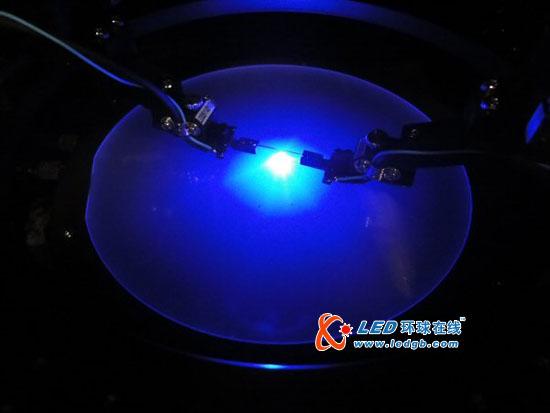LED manufacturer Lextar Electronics claims to be the first LED maker in Taiwan to demonstrate blue-light emission from a processed 6-inch-diameter LED wafer.
Lextar Electronics TAIEX: 3698 a Taiwan-based LED manufacturer, announced recently the successful demonstration of blue-light emission from a processed 6-inch wafer. The company claims to be the first LED maker in Taiwan to light up a 6-inch processed wafer.
According to Lextar, its New Process Project Team has employed unique exposure and grinding technology [to] avoid the issue of wafer warp and crack, which is the most challenging in 6-inch chip processing.

Blue-light emission from a processed 6-inch wafer
Processing on 6-inch or more accurately 150-mm substrate wafers is viewed as the likely next step for many LED makers due to significant advantages compared with using smaller wafer sizes. Sapphire wafer maker Rubicon has an ongoing contract to supply 6-inch sapphire wafers to LG Innotek.
Cree is building a new 150-mm LED wafer production facility in Research Triangle Park RTP while Philips Lumileds is already mass-producing LEDs on 150-mm wafers, according to a recent announcement.
Lextar is part of the BenQ Group, which also includes LCD panel maker AU Optronics. Lextar currently has 3 manufacturing plants in Taiwan, and will set up another one in Suzhou, China in 2011. The new manufacturing site at the Suzhou Science Industrial Park will integrate upper-, middle- and down-stream manufacturing i.e. from epitaxy through to packaging and system integration. Covering a land area of over 240,000 sq.m and with a projected 5,000 employees, the facility will be ready for production in 2011 with a total investment of USD 500 million.
Lextar has also announced that its December 2010 revenue was NT$ 666 million US$ 22.9 million up 16.6% compared with November 2010 and up by 85.8% year-on-year.
In the fourth quarter of 2010, Lextar's unaudited revenue totaled NT$ 1.73 billion US$ 59.4 million For the year ended December 31, 2010, unaudited revenue totaled NT$ 8.1 billion US$ 278 million This figure represents a 297% year-on-year increase compared with NT$ 2.03 billion US$ 69.7 million in 2009.
Related News
Photos
More>>trade
- Digitimes Insight: Japan quake unlikely to hit global LED supply chain
- Osram Opto expands LED capacity with 6-inch conversion
- LED phosphor suppliers are affected by China's rare-earth export quotas
- YoungTek posts sequential growth in February revenues, Single Well revenues
- Digital Lumens supplies LED lighting systems for 7 Americold warehouses





